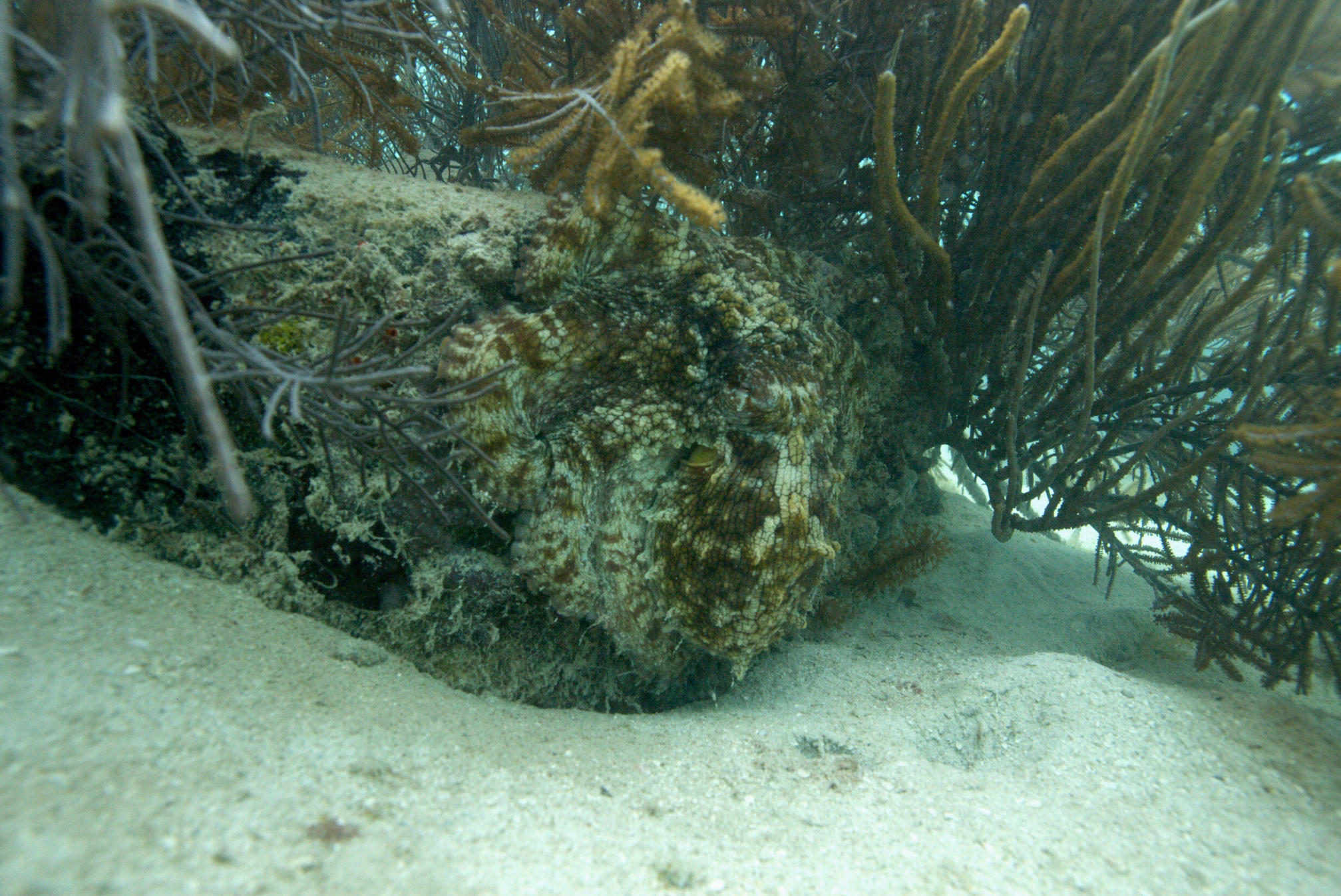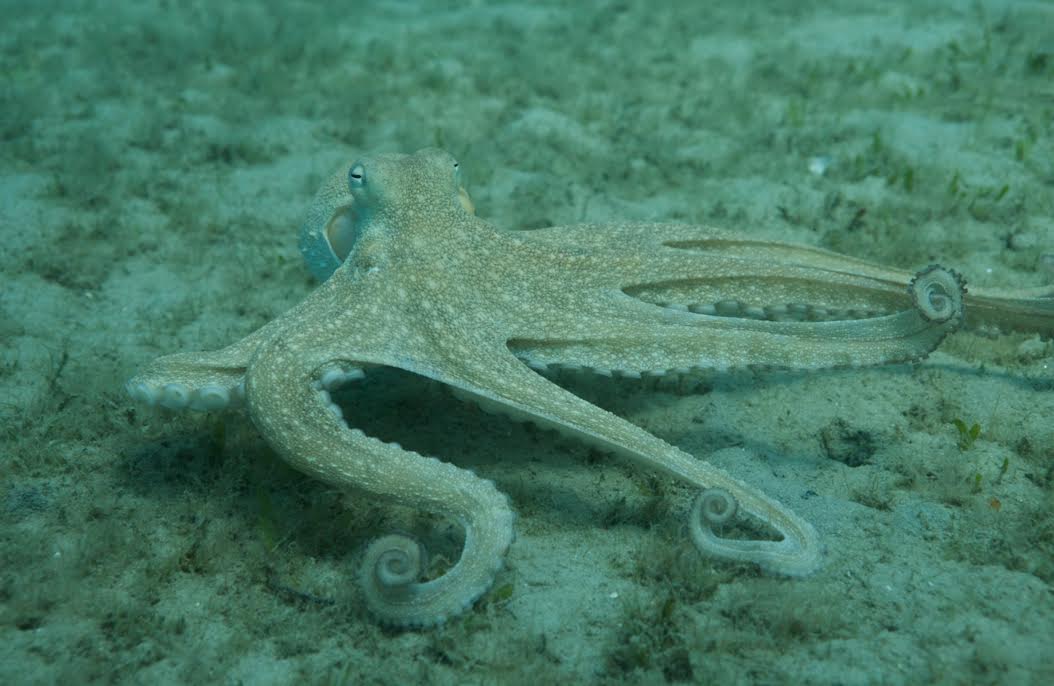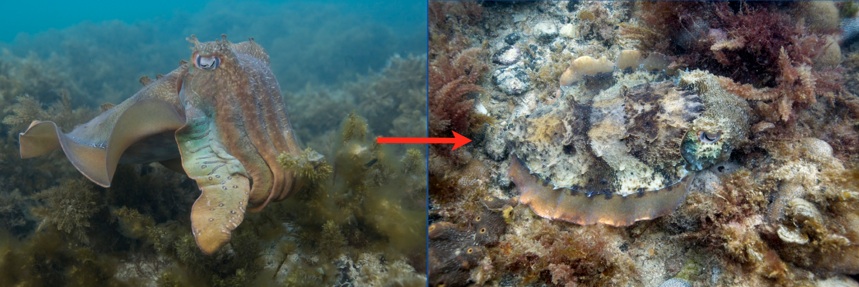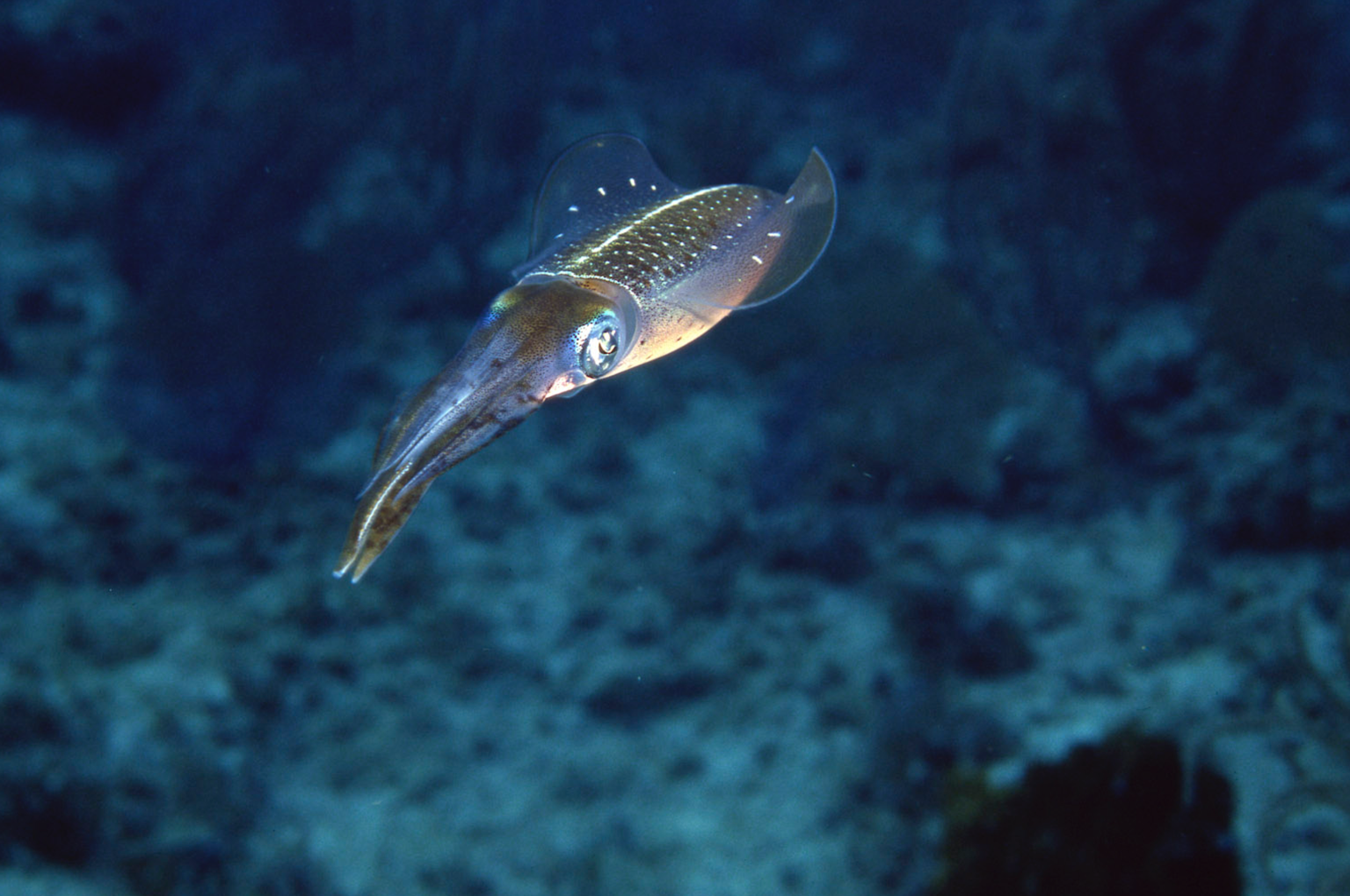Secrets of Cephalopod Camouflage
Ethologist Roger Hanlon has devoted a career to studying how octopuses, squid, and cuttlefish become inconspicuous.

A common octopus (Octopus vulgaris) in hiding. Can you spot it? Photo courtesy of Roger Hanlon
Roger Hanlon’s infatuation with cephalopods began shortly after one scared the living daylights out of him.
He was snorkeling in a shallow coral reef in Panama in 1968 when a blast of water swept across his stomach, startling him. “I sort of circled around, looking [for] what on earth scared me so much,” he recalls. “I couldn’t see what it was, but just kept staring in this depression of coral, and eventually saw an octopus sitting there.”
He patiently observed the creature, taking note of its changing camouflage as it slowly moved around to feed. After about 20 minutes, “I was hooked for life,” he says.

Hanlon is now a senior scientist at the Marine Biological Laboratory in Woods Hole, Massachusetts, where his lab primarily focuses on studying the mechanisms behind cephalopod camouflage and signaling, as well as the behavior and sensory experiences of these soft-bodied creatures. Over the course of 35 years, his team has published more than 200 scientific papers on cephalopods, according to Hanlon.
One feature that fascinates Hanlon is the rate at which these soft-bodied creatures can transform. “Very few animals can change their camouflage, especially quickly,” he says. “Their primary source of defense is not being detected or recognized, and they’ve evolved this capability to a greater degree than other animals we know of.” At least 30 of his published studies have entailed experimental setups designed to tease apart how cephalopods change their color and body patterning “so rapidly, with such a sophisticated result.”
And Hanlon has another claim to fame: He’s the human star of one of Science Friday’s most popular videos, “Where’s the Octopus?,” as well as its sequel, “Where’s the Cuttlefish?”
Science Friday caught up with Hanlon to discuss what he’s learned so far about cephalopod camouflage, what burning questions still remain, and why the octopus footage featured in our SciFri video was particularly impressive.
You’ve described cephalopod coloration as a three-layered system. Can you elaborate on that?
You have a top layer of chromatophores [pigmented organs]; then you have a middle layer of iridophores, which produce the iridescent structural coloration; and then you have a basement layer of leucophores [leuca means white]. So there are two mechanisms at play going on in the skin, and the combination of pigments and reflectors gives optical diversity.
The top layer of chromatophores is actually in three colors and three layers—yellow, red, and brown. There’s one big nerve bundle that controls all three layers. Another set of neurons controls the change of iridescence. The bottom layer doesn’t have any neurons; it always looks the same all the time. But if you selectively expand pigments over some parts of the white base layer of leucophores and not others, then you create high contrast.
![A close-up of skin from the common cuttlefish (Sepia officinalis). The top layer of cephalopod skin contains pigmented cells called chromatophores. Radial muscles extend from each cell “like the spokes of a bike [wheel], and they’re anchored out in the periphery,” says Hanlon. When a cephalopod contracts those muscles, the cell opens into a disc of color. Photo courtesy of Roger Hanlon](http://www.sciencefriday.com/wp-content/uploads/2016/06/Sepia-officinalis-skin_Roger-Hanlon.jpg)
So, these three layers play into color and pattern. Cephalopods also have bumps in the skin called papillae. Do they contribute to skin texture?
Yes, exactly right. Something that’s really unique about these animals that no other animal group has is the malleable 3-D texture of the skin. That 3-D texture is an extra attribute in camouflage that is very important for visual deception.
In the last few years, we’ve done work to figure out, anatomically, how they make those bumps, and it’s basically a muscular hydrostat. The papillae in an octopus or a cuttlefish have concentric muscles and vertically oriented muscles, and when they squeeze the concentric ones, they relax the vertical ones, and the bump goes up. And when they contract the vertical ones and relax the concentric ones, the bump goes down, kinda like a balloon full of water—squeeze in the middle, something has to give elsewhere. That’s a very crude explanation of how it works, but that’s basically it.
One of the vexing questions is: How do they control that? These animals don’t have binocular stereopsis like a human does—they have their eyes where your ears are, so they’re looking at the 3-D texture of the background with one eye, and then they reproduce that in their skin. That’s really a pretty spectacular but yet unknown mechanism.
Do cephalopods have a finite set of camouflage to draw on, or is there limitless variation?
It’s absolutely not limitless. What really got me into all of this is how fast it all occurs. How could they analyze so much visual information in the background and then orchestrate tens of millions of chromatophores, god knows how many millions of iridophores, not to mention all those skin bumps—and there are thousands of those—and do it all within a second? The amount of visual processing that would have to take place to look at all the information surrounding them would require a supercomputer the size of a Volkswagon, and, you know, octopuses have a big brain, but it’s not that big. There’s gotta be a shortcut to that seemingly impossible thing they’re doing.
And the shortcut is that there aren’t dozens and dozens of camouflage patterns. I’ve analyzed tens of thousands of images of these animals underwater and in the lab, and what we’re finding is three to five basic pattern templates they use to create camouflage on any background. This is completely counterintuitive. But it accounts for the speed.
Here’s the concept: If the animals only have three basic pattern decisions to make, then they only need one simple visual cue in the background to tell them to turn on pattern 1, a different visual cue to turn on pattern 2, and a different one for pattern 3. So that simplifies the neural processing enormously—perhaps they can ignore most of the information they see in a complex coral reef surrounding them. We call these patterns uniform, mottle, and disruptive.
There is some variation on color and contrast, but they’re getting the pattern decision done really fast, and all the rest comes a few milliseconds later. We don’t understand all of the neural part—we don’t have enough data—but I think our general idea is holding up to experimentation.
By the way—we’ve not published this—but we’re looking at a lot of animals. I’ve got images of butterflies and birds and orca whales, and all sorts of animals, and you can fit them into these categories of uniform, mottle, and disruptive, with some artistic license. The way I like to explain it is that these animals have figured out how to exploit some basic conserved features of all animal predator vision. I think that is the key point.
Can they mix and match different patterns?
They can mix and match them a little bit. We’ve actually done and published experiments where we gave the animal [a European cuttlefish] information in the left eye that said ‘go disruptive,’ and we gave it different information in the right eye that said ‘go mottle,’ and we wanted to see what the animal would do. What they don’t do, ever, is go mottle on one side and disruptive on the other, because any bilateral asymmetry like that will be picked up, and they would definitely be dead meat. So they are doing a little bit of mixing and matching uniformly, over the whole body surface. It’s a really cool system, very adaptable.
The burning question among the hard-core vision scientists is whether or not there’s a continuum among those camouflage patterns or if they are discrete subsets. That argument is not fully resolved.

Do cephalopods use different types of camouflage for different purposes?
Yeah, absolutely. When they’re on a flat, two-dimensional background or a mild, three-dimensional background, they’ll use general background resemblance [what some might call background matching], which is meant to cut down on detection.
But if you can’t avoid being detected, then you go to what’s called disruptive patterning, which impedes recognition. So in this case, the animal will literally look unlike itself by creating all kinds of high-contrast components of the pattern so that it’s hard to tell where the edge is, and where the head is, and where all the appendages are.
And they’ll also do what is the silliest term of all, masquerade, which is looking like some other object in the visual background. So, for example, if a cuttlefish is moving across an open sand plain and there’s a rock or an algae nearby, the animal will make itself look like the rock or the algae rather than the sand—they’re specifically looking at that object and more or less imitating it.
There is also mimicry, which is looking and acting like another animal. The mimic octopus in Indonesia and the one in Florida will morph themselves into the flat shape of a flat fish or a flounder when they’re on an open sand plain, and they’ll swim with that kind of behavior, and they’ll also put on a pattern that in many cases looks like a flounder. So in this case, they’re imitating a very common fish in the area. It’s not camouflage per se; it’s sort of a subset in which, again, they are not looking like an octopus.
I understand that cephalopods are color-blind.
Yep, every bit of evidence we have says that they’re color-blind, yet they seem to be color-matching the background. So how do they do it? And the answer is, we just don’t know.
But this leads to a potentially new, exciting thing. Because of this inability to understand how they do color-matching, we asked whether or not they can perceive light in some way outside of the eyes. We did a gene search and did a lot of antibody work and showed that opsin molecules are distributed throughout the skin of cuttlefish and squids, and another lab showed that they’re in octopus. These are the same opsin molecules that are in the animal’s retina detecting light. So this means that, hypothetically, the animals can detect light somehow with their skin.
Our group also showed that, not only are the same opsin molecules there, but two other molecule classes that are needed in a cascade system to detect light in the retina are also in the skin—even more evidence that they’re there to do something with light. But we didn’t produce any good behavioral evidence to show that the skin reacts to light.
However, Todd Oakley’s lab at UC Santa Barbara published a paper back to back with ours this past year, and he was using octopus as a model organism, and he did get the skin to react to light. Collectively, our two papers were published in the Journal of Experimental Biology.
But this doesn’t get to the color question, because the opsin molecules that we were able to discern are still tuned only to one color. That means they’re monochromatic. But you need to be a dichromat or a trichromat or a tetrachromat to discern color.
Our latest hypothesis is that those opsins in the skin might be regulating the overall brightness or intensity of the skin. Still, there might be other opsins in the skin tuned to other wavelengths, or it might be that the chromatophore pigments overlie these opsin molecules—like, a yellow pigment chromatophore overlying an opsin that’s tuned to blue could give you a little bit of color discrimination. But we’re stretching biology here; there’s no data.

Is there anything that you really hope to ferret out about cephalopods?
Are they really color-matched to the background in the eyes of predators? This is a big question that goes well beyond cephalopods. What does the world look like in the eye of the beholder?
Everything we do and how we see and all our computer screens and everything are only for human vision, and this is not what the world looks like to other animals, so we have just developed a hyper-spectral [meaning, lots of colors] camera that has 16 colors in every pixel instead of three colors, spread from the ultraviolet through the visible range.
Now what we do is we take a picture of a camouflaged octopus on a reef or a butterfly in a forest, and we go back in post-processing and ask, what does this look like to an avian predator like a hawk, or a diving bird, or a fish underwater that’s tetrachromatic? We take out most of the 16 colors, and we leave in the two, three, or four that we know that animal predator is tuned to, and we image that in the color space geared more carefully to what that predator, not humans, can see.
This is a breakthrough, because the technology previously did not allow people to make cameras that had so much color in them. That camera has been built; we’ve been using it for about a year on land. The underwater housing is being made as we speak. Sensory ecologists, sensory biologists, vision people have been wanting for a long time to know what the world looks like to other animals, and now we’ve got a way forward. I think it’s really going to change our view, both on land and the sea, of what color animals are seeing, either in a color-camouflaged prey, or during conspicuous signaling for mate attraction, or anything like that.
I have to ask about Science Friday’s “Where’s the Octopus?” video. At the beginning, you said you screamed—did you scream in the water or when you saw the footage that you recorded?
I screamed in the water right away! I just knew I had something really great. I’d been filming that animal for 45 minutes. When I got out of the water maybe 10 minutes later, I screamed bloody murder, and everyone thought I was having a diving accident. [He assured them that he was okay.]
Why did that one octopus make you scream if you’ve been studying these organisms for so many years?
Because I had never seen, visually, that dramatic sequence so clearly framed. I’ve tried to shoot a sequence like that ever since and never come close. It was a lucky shot, but luck favors the prepared—I was doing a very regimented study of the animal, and I was approaching it at different speeds, and this was the fifth time I approached it, and this time, rather than approaching fast, I came in super slowly and curved around. The dome port on the video camera was no more than three to four inches from the animal before it decided to move, because I came in so slowly, and that made the difference. It was just the perfect storm of getting everything to happen together.
This interview has been edited for space and clarity.
With every donation of $8 (for every day of Cephalopod Week), you can sponsor a different illustrated cephalopod. The cephalopod badge along with your first name and city will be a part of our Sea of Supporters!
Julie Leibach is a freelance science journalist and the former managing editor of online content for Science Friday.